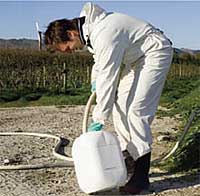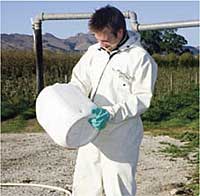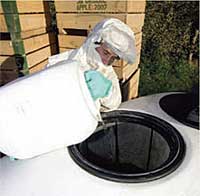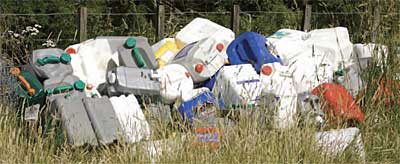Container disposal
Empty containers must be disposed of safely - there are risks to people and the environment from not doing this correctly.
If you are using agrichemicals, it is your responsibility to make sure empty containers are dealt with properly.
Both regional and district councils may have requirements for container disposal so check your local plans.
The product's label should have some directions for container disposal.
Triple rinsing
Containers must be clean before disposal. For plastic or metal containers, the usual method is triple rinsing. Rinsing should be carried out immediately after emptying the container, as residues are more difficult to remove when dry. More details about triple rinsing can be found in Agrecovery's brochure.

Step 1. Partially fill the container with clean water and replace the cap securely.
|

Step 2. Shake the container vigorously for at least 30 seconds, so the rinse water reaches all inside surfaces
|
 |
Step 3. Empty the rinse water into your sprayer tank. Let the container drain for an extra 30 seconds after the flow reduces to drops.
Repeat this sequence two more times.
(Images courtesy of Agrecovery)
|
Triple rinse plastic bags, plastic lined and waxed cardboard containers to ensure complete removal of residues before disposal. Cardboard containers which have not had contact with agrichemicals should be recycled.

Disposal options
There are several disposal options available to you, but not all may be available in your area.
- Container return: this applies to some types of containers only. The original label must be readable on the container.
- Recycle: some types of metal and plastic containers can be 'handed in' to recycling services such as Agrecovery.
- Public landfill: punch holes in the containers to make them unusable. Check with your district council for any other requirements before disposal.
- Private landfill: check with your district council to ensure that private landfills are permitted in the district plan. Render the containers unusable by flattening, breaking or puncturing before being buried.
 |
Visit the AgRecovery website for further details of its Rural Recycling Programme which provides New Zealand's primary sector with responsible and sustainable systems for the recovery and recycling of persistent 'on-farm' waste products. Look out for this logo on agrichemical containers which indicates the container can be recycled for free at one of AgRecovery's many collection sites:
|
|